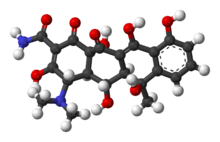Oxytetracycline
 | |
|---|---|
 | |
| Systematic (IUPAC) name | |
| (4S,4aR,5S,5aR,6S,12aS) -4-(dimethylamino)-3,5,6,10,11,12a-hexahydroxy -6-methyl-1,12-dioxo-1,4,4a,5,5a,6,12,12a-octahydrotetracene -2-carboxamide | |
| Clinical data | |
| Pregnancy cat. | D: (United States) D: (Australia]) |
| Legal status | Prescription only |
| Routes | Oral, Ophthalmic |
| Pharmacokinetic data | |
| Half-life | 6-8 hours |
| Excretion | Renal |
| Identifiers | |
| CAS number | 79-57-2 |
| ATC code | D06AA03 G01AA07 J01AA06 S01AA04 QG51AA01 QJ51AA06 |
| PubChem | CID 5353856 |
| DrugBank | DB00595 |
| ChemSpider | 10482174 |
| UNII | SLF0D9077S |
| KEGG | D00205 |
| ChEBI | CHEBI:27701 |
| ChEMBL | CHEMBL1517 |
| Chemical data | |
| Formula | C22H24N2O9 |
| Mol. mass | 460.434 g/mol |
| SMILES
| |
| |
| | |
Oxytetracycline was the second of the broad-spectrum tetracycline group of antibiotics to be discovered.
Oxytetracycline works by interfering with the ability of bacteria to produce essential proteins. Without these proteins, the bacteria cannot grow, multiply and increase in numbers. Oxytetracycline therefore stops the spread of the infection and the remaining bacteria are killed by the immune system or eventually die.
Oxytetracycline is a broad-spectrum antibiotic, active against a wide variety of bacteria. However, some strains of bacteria have developed resistance to this antibiotic, which has reduced its effectiveness for treating some types of infections.
Oxytetracycline is still used to treat infections caused by Chlamydia (e.g. the chest infection psittacosis, the eye infection trachoma, and the genital infection urethritis) and infections caused by Mycoplasma organisms (e.g. pneumonia).
Oxytetracycline is also used to treat acne, due to its activity against the bacteria on the skin that cause acne (Propionibacterium acnes). It is used to treat flare-ups of chronic bronchitis, due to its activity against the bacteria usually responsible, Haemophilus influenzae.
Oxytetracycline may also be used to treat other rarer infections, such as those caused by a group of micro-organisms called rickettsiae (e.g. Q fever). To make sure the bacteria causing an infection are susceptible to it, a tissue sample is usually taken, for example a swab from the infected area, or a urine or blood sample.
History
It was first found near Pfizer laboratories in a soil sample yielding the soil actinomycete, Streptomyces rimosus by Finlay et al. In 1950, a celebrated American chemist, Robert B Woodward, worked out the chemical structure of oxytetracycline, enabling Pfizer to mass-produce the drug under the trade name, Terramycin. This discovery by Woodward was a major advancement in tetracycline research and paved the way for the discovery of an oxytetracycline derivative, doxycycline, which is one of the most popularly used antibiotics today.
Indications
Oxytetracycline, like other tetracyclines, is used to treat many infections, both common and rare (see Tetracycline antibiotics group). Its better absorption profile makes it preferable to tetracycline for moderately severe acne at a dosage of 250–500 mg four times a day for usually six to eight weeks at a time, but alternatives should be sought if no improvement occurs by three months.[1] Avoid milk, iron, zinc or indigestion remedies while taking Oxytetracycline. Take before food or on an empty stomach.
It is sometimes used to treat spirochaetal infections, clostridial wound infection and anthrax in patients sensitive to penicillin. Oxytetracycline is used to treat infections of the respiratory and urinary tracts, skin, ear, eye and gonorrhoea, although its use for such purposes has declined in recent years due to large increases in bacterial resistance to this class of drugs. The drug is particularly useful when penicillins and/or macrolides cannot be used due to allergy. It may be used to treat Legionnaire's disease as a substitute for a macrolide or quinolone.
Oxytetracycline is especially valuable in treating nonspecific urethritis, Lyme disease, brucellosis, cholera, typhus, tularaemia. and infections caused by Chlamydia, Mycoplasma' and Rickettsia. Doxycycline is now preferred to oxytetracycline for many of these indications because it has improved pharmacologic features.
The standard dose is 250–500 mg six-hourly by mouth. In particularly severe infections, this dose may be increased accordingly. Occasionally, oxytetracycline is given by intramuscular injection or topically in the form of creams, ophthalmic ointments or eye drops.
Veterinary indications
Oxytetracycline is used to control the outbreak of American foulbrood and European foulbrood in honeybees.
Oxytetracycline can also be used to correct breathing disorders in livestock. It is administered in a powder or through an intramuscular injection. American livestock producers apply oxytetracycline to livestock feed to prevent diseases and infections in cattle and poultry. The antibiotic is partially absorbed in the gastrointestinal tract of the animal and the remaining is deposited in manure. Researchers at the Agricultural Research Service studied the breakdown of oxytetracycline in manure depending on various environmental conditions. They found the breakdown slowed with increased saturation of the manure and concluded this was a result of decreased oxygen levels. This research helps producers understand the effects of oxytetracycline in animal feed on the environment, bacteria, and antimicrobial resistance.
Side effects
Side effects are mainly gastrointestinal and photosensitive allergic reactions common to the tetracycline antibiotics group. It can also damage calcium-rich organs, such as teeth and bones, although this is very rare. It sometimes causes nasal cavities to erode, quite commonly; the BNF suggests, because of this, tetracyclines should not be used to treat pregnant or lactating women and children under 12 except in certain conditions where it has been approved by a specialist because there are no obvious substitutes. Candidiasis (thrush) is not uncommon following treatment with broad-spectrum antibiotics.
Formulation
The most common form is tablets containing 250 mg of oxytetracycline as the dihydrate.
References
- ↑ British National Formulary 45 March 2003
| ||||||||||||||||||||||||||
| |||||||||||||||||||||||||||||||||||||||||||
| ||||||||||||||||||||||||||||||||||||||||||||||||||||||||||